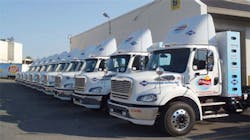Natural gas becoming viable option for foodservice fleets
“Natural gas is different, but not so different that you can’t figure it out with proper training,” said Erik Neandross, who laid out the pros, cons, and considerations in using natural gas (NG) for fleet operations during a session at the Distribution Solutions Conference recently.
Neandross is president of Gladstein, Neandross & Associates, a consulting company that helps clients plan and implement NG vehicle deployment.
Pros of NG center on cost savings and long-term availability of supply. Cons concern storage and infrastructure for delivery and distribution, both of which are not yet plentiful for this fuel source. Two other considerations must also be addressed: first, the feasibility of switching to NG for a particular distributor; and second, the financial investment it takes to do so, especially considering timing of return on investment.
Neandross explained the differences between compressed natural gas (CNG) and liquified natural gas (LNG) in terms of usage, storage, composition, and cost. Basically, CNG requires compression, thus tanks that are thicker-walled. CNG also may require longer time to fill a tank. LNG, on the other hand, is cooled to a point of being a cryogenic liquid and needs to be stored in insulated tanks. Neandross said the selection of one over the other depends on weight and range of the vehicle. LNGs are somewhat better for long-haul vehicles, while CNG is preferable for intra-city or regional routes.
Both, however, are less expensive than diesel. Using the price of diesel the day of his presentation (October 30, 2012) and converting it to a diesel gallon equivalent for accurate comparison, Neandross gave these numbers: diesel, $3.70; CNG, $1.49; and LNG,: $1.94.
Neandross used a number of case studies to make his points, ranging from Sysco Corporation to foodservice manufacturers to truck rental companies. So far, Sysco has converted one-half of the company’s Los Angeles fleet (185 trucks) to run on LNG. Once this test is approved, the company will look to roll out the program to other operating companies. Other food companies working on deployment include Albertsons, Core-Mark International, Vons/Safeway, Frito-Lay/Pepsi, Golden State Foods, and Kroger.
As to infrastructure, there are currently 1,100 NG filling stations across the United States, but fewer than 10% of them are usable for heavy-duty trucks. A fuel station costs around $1.5 million to build, Neandross said, making it a considerable investment for a distributor. Maintenance facilities need to be built to accommodate safety issues surrounding storage of natural gas—specifically, flammability—and costs are approximately $40,000 per bay. Also, the cost to purchase an NG vehicle is $45,000 to $50,000 greater than that for a diesel truck. All told, return on investment can be attained in two to five years depending on the number of vehicles converted to NG.
NG doesn’t work in every situation, said Neandross. Considerations include the economics of cost savings versus investment. Two strong positives include long-term availability of supply, plus grants and incentives can reduce time to reach ROI. Assuming that fracking continues to be approved, the supply of shale gas is estimated at up to 100-plus years.\
Neandross said his firm has a high degree of success obtaining government grants and incentives for clients. He cautioned that these are taxable and may need to be repaid; however, they are advantageous for initiating an NG program.
He advised distributors to start soon if they are interested in converting from diesel to NG. While the project development time from planning to implementation can take considerable time, effort, and money, he said “the future looks good for NG users.”
For full information on the upcoming 2013 Distribution Solutions Conference, visit www.go-distribution.com.

